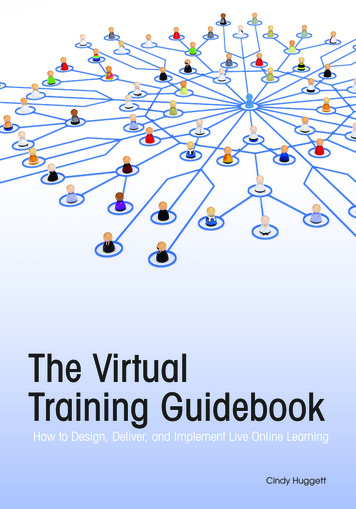
Transcription
The VirtualTraining GuidebookHow to Design, Deliver, and Implement Live Online LearningCindy Huggett
The VirtualTraining GuidebookHow to Design, Deliver, and Implement Live Online LearningCindy Huggett
2013 American Society for Training & Development (ASTD)All rights reserved. Printed in the United States of America.No part of this publication may be reproduced, distributed, or transmitted inany form or by any means, including photocopying, recording, or otherelectronic or mechanical methods, without the prior written permission of thepublisher, except in the case of brief quotations embodied in critical reviewsand certain other noncommercial uses permitted by copyright law. Forpermission requests, please go to www.copyright.com, or contact CopyrightClearance Center (CCC), 222 Rosewood Drive, Danvers, MA 01923 (telephone:978.750.8400; fax: 978.646.8600).All trademark attributions are listed at the end of the book. Adobe productscreen shot(s) reprinted with permission from Adobe Systems Incorporated.ASTD Press is an internationally renowned source of insightful and practicalinformation on workplace learning, performance, and professionaldevelopment.ASTD Press1640 King Street Box 1443Alexandria, VA 22313-1443 USAOrdering information: Books published by ASTD Press can be purchased byvisiting ASTD’s website at store.astd.org or by calling 800.628.2783 or703.683.8100.Library of Congress Control Number (for print only): 2013955127ISBN-10: 1-56286-861-6ISBN-13: 978-1-56286-861-1e-ISBN: 978-1-60728-648-6ASTD Press Editorial Staff:Director: Glenn SaltzmanManager and Editor, ASTD Press: Ashley McDonaldCommunity of Practice Manager, Learning Technologies: Justin BrusinoEditorial Assistant: Ashley SladeText and Cover Design: Marisa Kelly
ContentsForeword. vAcknowledgments. viiChapter 1: Introduction. 1Chapter 2: Get Ready. 9Chapter 3: Select Technology.33Chapter 4: Design Content.61Chapter 5: Prepare Facilitators and Producers.89Chapter 6: Prepare Participants. 115Chapter 7: Create Success Through Logistics. 143Chapter 8: Special Considerations: Global Issues,Evaluation Metrics, and Future Trends. 167References. 187Resources. 191Trademark Attributions. 196About the Author. 197Index. 199iii
ForewordCindy Huggett grabbed my attention the first time I saw her present at an international conference for the American Society for Training & Development (ASTD).She was presenting on webinars and made it look easy and engaging. I could tell alot of preparation and experience had gone into her session.Impressed with her techniques for making webinar instruction and learninginteractive, I introduced myself after class. Since then, we’ve had many conversationsand I appreciate the insight and skill she has in making virtual learning become morealive. Out of these conversations came a foundation of trust and respect, and that ledus to collaborate on SCORE for Webinars, which will come out in early 2014.Cindy is such a valuable asset to the training industry, and I really value the time Ispend working with her. She is a tremendous sounding board for ideas and has providedso much valuable guidance for me as a trainer, an author, and a company CEO.In The Virtual Training Guidebook, Cindy provides a comprehensive guide tolive online learning in an easy-to-follow, step-by-step format. The book begins withsimple definitions and ends with how to measure online training effectiveness aswell as a discussion on future trends.However, I feel this book is such an excellent resource because, while detailingher process for virtual training, Cindy stays true to the most important aspect—interaction and engagement in the learning process. Throughout her work, sheemphasizes the need to facilitate instruction and ensure participants are activelyengaged in their learning.After reading this book, I believe you will feel more comfortable and confidentin handling the technical and technological aspects of virtual training.Becky Pike PluthCEO of The Bob Pike GroupAuthor of Webinars with WOW Factorv
AcknowledgmentsA special thanks to the many business and training professionals who willinglyshared their advice and stories about their experience with virtual training: BeckyPike Pluth, Cheryl Scanlan, Dan Gallagher, Danielle Buscher, Darlene Christopher, David Smith, Erin Laughlin, Jeff Robinson, Jennifer Newton, Jill Kennedy,Jim Wilcox, John Hall, Justin Patton, Kassy LaBorie, Ken Hubbell, Lisa BrodethCarrick, Lorna Matty, Lucy Brown, Matt Murdoch, Peggy Page, Stephan Girard,Tara Welsh, Tracy Stanfield, Treion Muller, Trish Carr, and Wendy Gates Corbett,along with a few who chose to remain anonymous (you know who you are!). I amgrateful to each one of them for their willingness to offer wisdom and their lessonslearned. Their contributions have enriched this book. Thank you.I’m also extremely grateful to Wendy Gates Corbett for all of the time and effortshe spent reading early versions of the manuscript and for sharing her thoughts andsuggestions on the content. Her insights were invaluable and made this book muchbetter than it would have been otherwise.Thank you also to Justin Brusino and Ashley McDonald at ASTD Press fortheir enormous patience during the lengthy book writing process. Their encouragement and advice carried this book through from concept to completion.Finally, I dedicate this book to my best friend and husband, Bobby Huggett, whoendured hearing me type on the keyboard for hours on end over many nights andweekends. Without his love and support this book would never have been written.Cindy HuggettPsalm 115:1October 2013vii
Chapter2Get ReadyIn this chapter, you will learn four things you should do to get readyfor a virtual training implementation: Ask yourself, “What’s your end goal?” Define virtual training for your organization. Get the right people involved. Build an implementation plan.Whether you want to have an extensive virtual training course curriculum that willrequire months of planning or only want to have one single online session, an implementation plan will help you get ready to use virtual training in your organization.The first task in any implementation is to plan for success. As well-known authorStephen Covey once wrote, “Begin with the end in mind” (1989). The same thoughtis true for a virtual training implementation. Begin by thinking about the end goal.Discover Your End GoalThe planning journey will start with your first step, which should be to ask yourselfquestions such as: What’s our goal for this training program? What are we trying toaccomplish? What do we want to be different as a result of it? Do we need participantsto be more knowledgeable about a topic? Do we want them to behave differently?Take action on something? How will our organization change or improve as a result?What’s the best way to achieve these goals? How specifically would virtual traininghelp achieve these outcomes?By answering these questions, you define your vision of virtual training success.You determine the purpose of your initiative and articulate your desired end result.By intentionally setting goals, you can increase your likelihood of achieving them.These questions can also help you determine if virtual training is the appropriatesolution for your situation. Virtual training is not the answer just because everyoneelse is doing it or because it’s a shiny object that captures your passing interest.9
Chapter 2It may surprise you to hear that virtual training may not be the right solutionfor your organization. If by answering these questions, you realize that you’re implementing virtual training just because you have heard it’s a cheaper alternative totraditional training, or just because your employees are dispersed throughout theglobe, or just because a competitor is doing it, then those are not the right reasons.All of these might be contributing factors to your reasons for wanting to implementvirtual training. But the best reason to implement virtual training is that it will bethe best solution to meet your organization’s needs.When done well, virtual training can transfer knowledge, increase productivity,help you gain competitive advantage, and positively affect business results. Virtualtraining can help you reach a global audience. It can reduce travel costs for trainingbudgets. It can create opportunities for dispersed learners to interact with each otherand a facilitator. And it can help provide training to participants who may otherwisenot have access to instructor-led learning.The point is that you should be clear about the reasons for using virtual trainingimplementation. By beginning with the end, you can define what success will looklike for your organization.“Be really intentional about choosing {virtual training} as a modality. You bothgain and give up. We’ve never promised that virtual training is the same learningexperience as face-to-face training, but with a team located in cities around theworld it’s the most efficient way to deliver a consistent learning experience.”—Dan Gallagher, Vice President of Learning at Comcast;and author, The Self-Aware Leader (ASTD, 2012)Let’s say, for example, your organization decides to decrease administrative costsworldwide by switching to a new online expense reporting system. End users needto learn how to use this new system in order for the costs savings to be realized. Afterlooking at travel costs, participant locations, and trainer time, you determine thatlive online sessions will be the best way to both demonstrate and answer questionsabout the new features. You realize that virtual training will help you reach yourgeographically dispersed audience. And you believe the software skills content issuited to a virtual method.10
Get ReadySo you might define the goals and objectives for this initiative by factoring inthe organization’s aim to decrease administrative costs and determining what endusers specifically need to know and do with the new system features. These goals willhelp you define the learning objectives. But more importantly, they will help youdesign and deliver the appropriate type of virtual training for this initiative.What type of virtual training will you deliver? That takes us to the next step ingetting ready.Define Virtual TrainingOne of the other most important things to do near the start of your journey is todefine what your organization means by “virtual training.”Virtual training conjures up a myriad of definitions. While it probably meansonly one thing to you, it is certain to have a different meaning to someone else. Youmight think virtual training is any type of online course, while the person sittingnext to you thinks virtual training is self-paced asynchronous learning. And theperson down the hall might think virtual training is a webcast that has one presenterand hundreds of audience participants. Due to these disparate definitions, it makessense to start by defining what you and your organization will mean when you say“virtual training.”No one is to blame that we have so many meanings of virtual training. If youlook to how we use the term virtual in everyday life, the same pattern emerges. Wetalk about virtual reality, virtual teams, virtual wallets, virtual meetings, and virtualpresentations, just to name a few. A cursory web search of the word “virtual” turnsup over 1.2 billion hits. The lexicon of virtual training follows suit.So what is virtual training? The definition I typically use is:a highly interactive synchronous online instructor-led training class, with definedlearning objectives, with participants who are individually connected from geographically dispersed locations, using a web-based classroom platform.We’ll peel apart that definition in a moment, but first, let’s talk about what elsevirtual training could be.To some, virtual training is any type of training delivered online. This definitionwould include asynchronous self-paced e-learning, as well as synchronous onlineclasses. In this case, virtual training is considered to be synonymous with onlinelearning. If it happens on the web, either alone or together with another person,then it would fit into their definition.11
Chapter 2To others, virtual training encompasses any type of knowledge transfer thathappens to be in an online environment. This definition includes webcasts, webinars,and online presentations. If any type of information is shared using a web conferencing platform, then it might be considered virtual training.And still to others, virtual training refers to video conferencing or any type oftelecommunication. A group of learners could be huddled together in a conferenceroom in Pittsburgh, Pennsylvania, while another group could be together in Seattle,Washington, and a third group could be in Paris, France. They could be using theircompany’s official video camera setup installed in each room, or a more informalonline video sharing software. Just because participants are dispersed in multiplelocations, some would consider this style of video conferencing to be virtual training.The list of examples could go on. There are as many definitions of virtualtraining as there are types of training classes—which is why you need to establishup front what you mean by virtual training, and get everyone involved on thesame page.You might decide to use more than one type of virtual training in your organization. In fact, you probably will. Yet for each session, you should define exactlywhat your goal will be, and what method (that is, type of virtual training) you willuse to get there.I can’t stress enough: Set the appropriate expectations with everyone involved.Be intentional about your goals for each virtual session and ensure that everyone isaware of those intentions. The success of your virtual training implementation willdepend upon it.“It’s really important to call things by the right name and set those expectations.What you call something really influences the design and sets the stakeholdersexpectations.”—Peggy Page, Design Group Manager, TD BankLet’s return to dissecting my definition of virtual training. It’s one of the mostcommon descriptions used. To remind you, the definition is: a highly interactivesynchronous online instructor-led training class, with defined learning objectives, with12
Get Readyparticipants who are individually connected from geographically dispersed locations,using a web-based classroom platform.In other words, virtual training is (or has): Highly interactive—participants engage frequently, at least every fewminutes, with the facilitator, with the learning content, and with thevirtual classroom tools. Synchronous—participants meet together at the same time. Sometimesreferred to as “live” or in the case of virtual training, live online. Instructor-led—facilitated by a professional trainer or instructor. Defined learning objectives—clearly stated performance expectationsthat learners will be able to achieve as a result of actively participatingin the session. Geographically dispersed participants—learners are distributed and apartfrom one another. Moreover, each participant joins from his own deviceand has his own audio/telephone connection. Web-based classroom platform—a software program used for training thatallows for online screen and file sharing, and has participant interactiontools such as polling, chatting, and annotating.So a typical virtual training class might meet on a Thursday at 10 a.m., last90 minutes, and have 18 participants from various locations around the country.The group would meet online using a synchronous tool, such as Adobe Connector Citrix GoToTraining. The class would be led by a facilitator, and would result inthe participants learning a new skill that could be immediately applied to their jobs.Of course, your virtual training might not look like the one described above. Youmight have an alternate set of standards for timing, or number of participants, or eventhe learning outcomes. What’s most important is that you define what your organization means by virtual training, and that everyone involved is on the same page.Other Types of Live Online SessionsSince so many of the tips found in this book can be applied to the various types ofsynchronous online sessions, let’s also expand upon those common definitions.13
Chapter 2What Does a Virtual Training Class Look Like?In case you are brand new to virtual training, here is an illustration,adapted from my first book Virtual Training Basics.Michelle is a trainer for a large telecommunications company. She’slocated in Cincinnati, Ohio and will be facilitating a 60-minute virtual classon Thursday morning at 11 a.m. Eastern time. About a week prior to thetraining date, she sends an email message with directions and logisticsto her participants. About an hour prior to the start time, she sits at heroffice desk, logs into the virtual classroom software, and gets ready forthe event. She uploads slides, opens the first polling question, andprepares the virtual whiteboard. She completes all of her pre-classpreparation and waits for everyone to arrive.Around 10:50 a.m. Eastern time on Thursday, the participants start enteringthe classroom. They do this from the comfort of their own respectiveoffices: sitting at their own desks, opening up their Internet browsers,and clicking on the link from Michelle’s email message.One participant—Moira—is in her office in Dallas, Texas. She clicks on thelink and goes straight to the login page. She types in her name and emailaddress, and waits for the classroom software to load on her screen. Onceconnected, she sees the conference call number on screen, picks up herphone, and dials in, using her unique attendee ID displayed on screen.Moira hears Michelle’s voice on the line, and says hello to greet her. Theother participants follow the same steps to join the class.The participants are able to see what Michelle has prepared for them onthe screen. They see the names of the other attendees, the slides, a chatwindow, and the first polling question.The participants communicate with each other verbally and onlinethrough frequent activities such as typing in the chat window, respondingto polls, and writing on the whiteboard. At one point, Michelle assigns theparticipants into virtual breakout groups, and Moira is able to talk privatelywith her class partner Julie. They practice one of the new skills beforereturning to the large group for a debrief discussion.By 12 p.m., class finishes, and Michelle asks everyone to completea follow-up assignment to apply what they’ve just learned.14
Get ReadyWebcastA webcast primarily disseminates information from a speaker to a large audience. Aspeaker uses slides to present and share information. Sometimes a webcast includesmultiple speakers or a panel of experts. And usually a webcast has a large audience,anywhere from a few dozen to a few thousand attendees.A webcast is solely one-way communication from a presenter to attendees. Thinkabout a traditional television newscast—with a news anchor reading from a script,using visual aids to illustrate stories, and interacting with other news presenters. Atraditional newscast has little to no interaction with the audience, which is also trueof a webcast.If your organization were to pull a large audience together for a scripted townhall meeting, with presentations on the company strategy and only a short timefor Q&A at the end, then this type of meeting—if held online—could be calleda webcast.WebinarIn its traditional definition, a webinar is an online seminar. Like a webcast, awebinar is also primarily one-way communication from a presenter to attendees.However, webinars often employ interactive techniques such as polling, chatting, orwhiteboard annotating. If you think about how television newscasts have evolvedover time, many modern news programs now incorporate audience interactionthrough social media and other techniques. For example, a reporter might respondto viewers’ on-air questions or invite listeners to vote online and then report on thecollected results.It’s the same with a webinar. The information shared is mostly one-way fromspeaker to audience. The speaker(s) use slides to present, while periodically involvingattendees through polls and other brief interactions. While some webinars can behighly interactive, most are not.You might think of a webinar like a university class, with an expert professorbehind a podium and hundreds of students sitting in an auditorium. The class willhave some interactivity through questions-and-answers, assignments, and quizzes.But the large class size limits the type and frequency of interaction available. If yourorganization’s human resources department decided to hold informational sessionsabout a new company travel portal, and throughout the event they offered several15
Chapter 2opportunities for discussion and dialog, then this type of session—if held online—could be called a webinar.Attend a Free Webinar!A popular current trend is a specialized online session: the marketingwebinar. Organizations use these marketing events to share informationabout their products and services to hundreds or even thousands ofpeople. Organizations contract with thought leaders who speak on asubject, and invite everyone in their target market to this free event.Attendees register for a session so they can hear from the expert speaker.Organizations use this registration data so they can capture interest andfollow up with participants. At some point during the session, a sponsor’scommercial is usually shared with attendees.The positive trade-off is obvious—attendees learn something for free,while organizations capture valuable marketing data, and sponsorsgenerate advertising.The term webinar is so popular that many people believe it is synonymouswith virtual training. It’s increasingly common for organizations to call their virtualtraining sessions a webinar. Many popular speakers, authors, and trainers interchangethe word webinar for virtual training. I’ve even done it myself on numerous occasions.The intent behind calling virtual training a webinar is good—yet the effectcan potentially create challenges for several reasons. First, participants who haveattended passive webinars may expect to do the same in a virtual training class nameda webinar. Second, presenters may assume the session should be lecture-based, anddesign and deliver the session accordingly. Third, administrators may unknowinglyset up the event using a meeting platform instead of a training platform, whichcan affect the available features. When these expectations are mismatched—yourintent is an interactive virtual training class but the result is a passive presentation—then there is higher risk for failure. Therefore, if you choose to call your sessions awebinar, as many organizations do, be prepared to climb any extra communicationhurdles that may be required for success.16
Get ReadyWebcast, Webinar, or Virtual Training?The first main difference between a webcast, a webinar, and a virtualtraining class is the amount of participant interactivity in each one.Webcasts typically have the least amount of interaction, followed bywebinars, then virtual training classes. The second main difference is thenumber of participants. Webcasts tend to be the largest, then webinars,followed by virtual training classes. There is not a simple black-and-whitecalculation that will tell you which is which; instead it’s more like shadesof grey on a continuum.Video ConferenceWhen participants are huddled together in a conference room using a video cameraand viewing a screen that shows other groups huddled around other conferencetables with the same setup, it would be called a video conference. Some would callit a virtual meeting. If this setup is used for learning, then it could be called remotetraining or distance learning.Video conferencing systems used to be found only in sophisticated technologyenriched office meeting rooms; however, with new technologies and decreased costs,it’s becoming more common for this same setup to substitute for virtual training.If participants are together, and can see each other via video conference, thena trainer could join in and with the right design, facilitate a training class. It’ssynchronous, online, instructor-led, and has geographically dispersed participants.If you replace the video camera with a web conferencing platform then some wouldcall it virtual training. But unfortunately, that’s where defining this type of setup asvirtual training can become confusing.Most web conferencing platforms are designed for one person to use onecomputer. When a group of participants are sharing the same connection to a virtualtraining class, they have to combine their responses when responding to a poll, andtake turns typing in the chat window. It’s a different experience than each personconnecting on their own.The extra challenge is when you try to combine virtual training (one personwith one computer) with video conferencing (groups sharing one connection ina conference room). This setup creates stress on the design because activities haveto be designed in multiple ways for them to work. Single participants feel even17
Chapter 2more alone when they hear a room full of active learners, and the grouped togetherlearners usually miss out on the platform’s interactive features since they are nottouching the keyboard.If video conferencing is your definition of virtual training, then design, deliver,and implement for that type of training. It’s not a good idea to mix and match thetwo methods in the same class.“The worst mistake I have seen is treating a virtual webinar/training just likea meeting.”—Jill Kennedy, Learning & Development Specialist, Ally FinancialBlended LearningWhen multiple delivery methods, including virtual events, are thoughtfully combinedtogether into a training curriculum, the result is blended learning. Allison Rossettand Rebecca Vaughan Frazee define blended learning this way: “Blended learningintegrates seemingly opposite approaches, such as formal and informal learning,face-to-face and online experiences, directed paths and reliance on self-direction,and digital references and collegial connections, in order to achieve individual andorganizational goals” (Rosett and Frazee, 2006).It’s typical to find a combination of asynchronous self-paced activities andsynchronous live instructor-led events in blended learning. For example, a learnerin a blended interpersonal skills curriculum might receive instructions to completea self-paced assignment, then attend two live virtual training events with anotherself-paced assignment in-between. Each of these components in the blended learningprogram is an important piece to the overall learning outcome. Learners need tocomplete all components to realize full results.Blended learning is mentioned in this book because it’s so common to findlive online virtual training events as a significant component of a blended learningcurriculum. You can apply the common phrase—learning is a process, not an event—by including virtual training in a blend. Stringing together multiple virtual eventsin a series allows for more flexible learning implementations. Instead of a singlesix-hour training session, the curriculum could be four 90-minute sessions spread18
Get Readyout over time. It’s also an opportunity for participants to learn something on theirown and then meet together with a facilitator and other learners for skill practice.For example, last year I designed a blended communication skills trainingprogram for one of my clients. The participants began by attending a virtual kickoffsession to meet one another and learn about what to expect in the curriculum. Theyalso received a short, self-paced assignment to help prepare themselves for thelearning topics. Two weeks later, they met for an in-person workshop to learn andpractice fundamental skills, again receiving an assignment at the end. Over the nextfour weeks, the participants met for two virtual training classes with applicationassignments in-between. The entire blended curriculum was approximately 24hours of training time (including the assignments), and each component contributedto the learning outcomes.What About a MOOC?MOOC stands for “massive open online course.” A MOOC is typicallyoffered by colleges and universities as a way to open up education toall. Anyone with an Internet connection can sign up for a MOOC andparticipa
Stephen Covey once wrote, “Begin with the end in mind” (1989). The same thought is true for a virtual training implementation. Begin by thinking about the end goal. Discover Your End Goal . The planning journey will start with your first step, which should be to ask yourself ques











